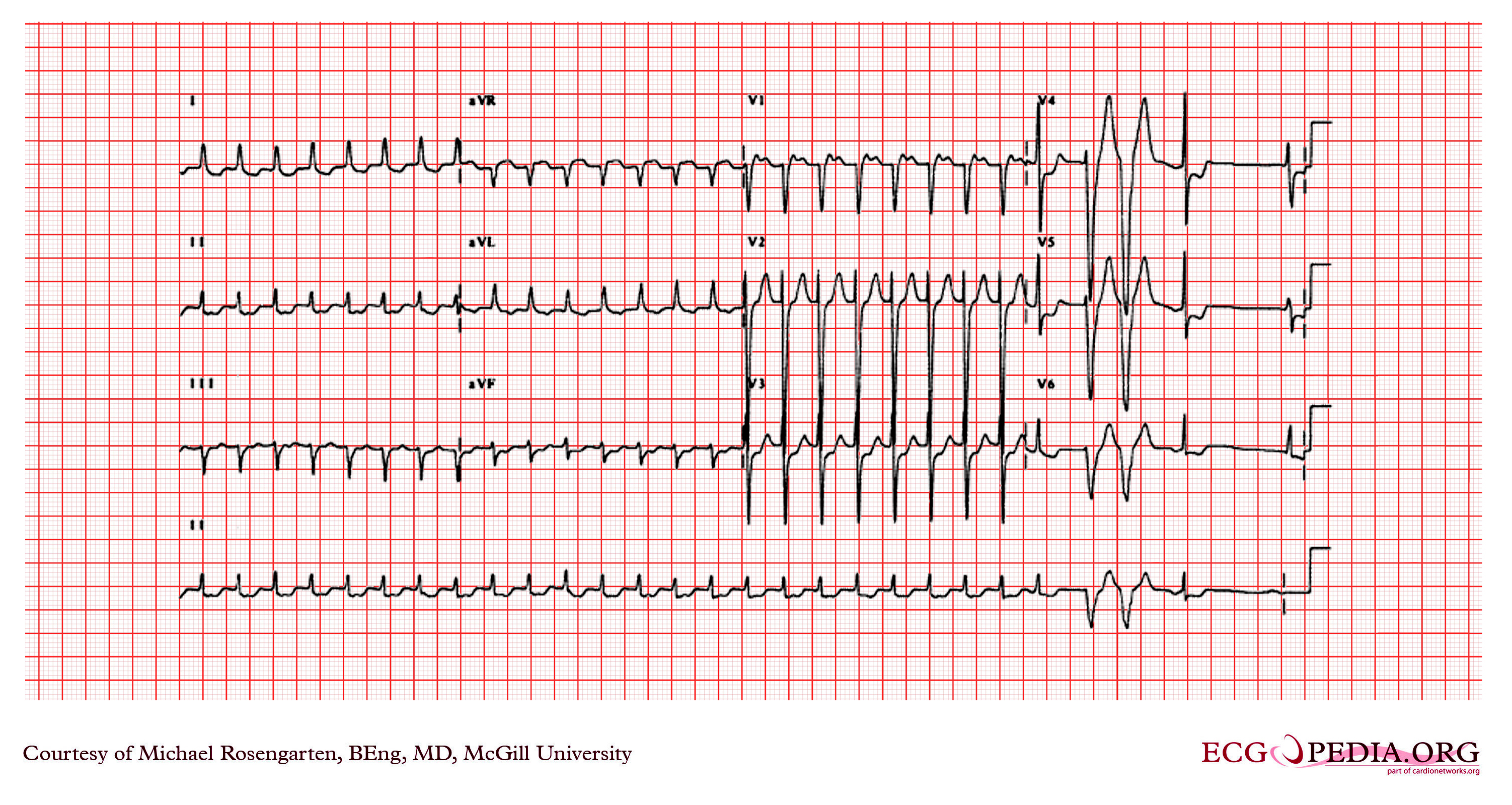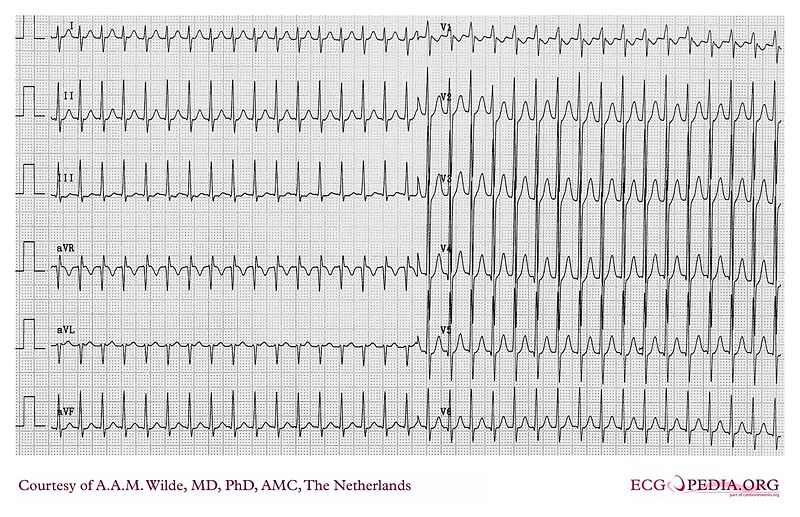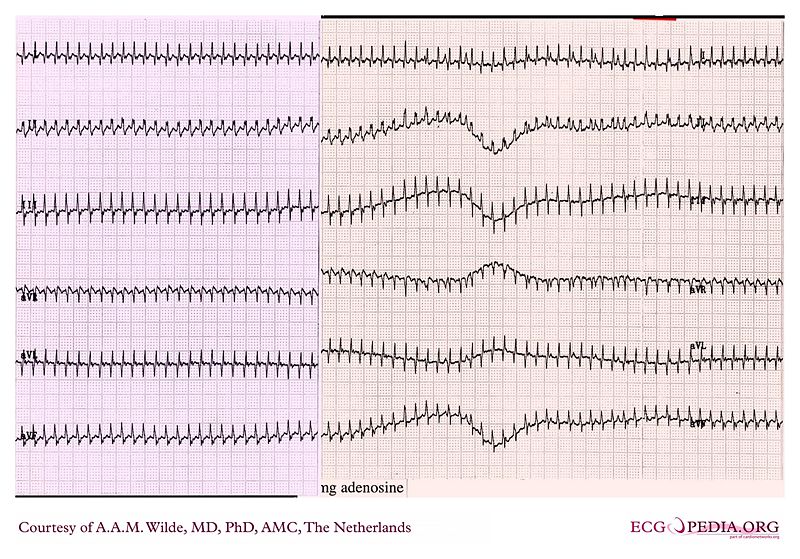Supraventricular tachycardia electrocardiogram: Difference between revisions
| (20 intermediate revisions by 3 users not shown) | |||
| Line 1: | Line 1: | ||
__NOTOC__ | __NOTOC__ | ||
{{Supraventricular tachycardia}} | {{Supraventricular tachycardia}} | ||
{{CMG}} | |||
==Overview== | ==Overview== | ||
The best method to diagnose [[supraventricular tachycardia]] is through electrocardiography. Presentation on EKG will vary depending on the subtype. In general, [[QRS complex]]es tend to be tall and narrow, [[P waves]] are absent, and rate is greater than 100 beats per minute. [[Asystole]] may occur due to tachycardia-mediated suppression of the sinus node when the rhythm is in AVNRT. | |||
==Electrocardiogram== | ==Electrocardiogram== | ||
Shown below is an EKG example of supraventricular tachycardia. The heart rate is around 185 bpm. It is somewhat unusual presentation for someone with [[angina]]. The [[arrhythmia]] terminated with [[adenosine]] which has a powerful [[cholinergic]] effect that blocks conduction through the [[AV node]]. | |||
[[Image:Svtadenosine.jpg|center| | [[Image:Svtadenosine.jpg|center|500px]] | ||
Copyleft image obtained courtesy of ECGpedia, http://en.ecgpedia.org/wiki/File:E345.jpg | Copyleft image obtained courtesy of ECGpedia, http://en.ecgpedia.org/wiki/File:E345.jpg | ||
---- | ---- | ||
Shown below is an EKG depicting a tachycardia at a rate of 190/min with narrow QRS complexes indicating supraventricular tachycardia. | |||
[[Image:SVT.jpg|center| | [[Image:SVT.jpg|center|500px]] | ||
Copyleft image obtained courtesy of ECGpedia, http://en.ecgpedia.org/wiki/File:De-AW00011.jpg | Copyleft image obtained courtesy of ECGpedia, http://en.ecgpedia.org/wiki/File:De-AW00011.jpg | ||
---- | ---- | ||
Shown below is an EKG recording of a patient who goes from sinus rhythm to a [[wide complex tachycardia]] at about 130/min. The [[wide QRS]] though disappears after nine complexes and is replaced by narrow complexes at a slightly slower rate. No [[P wave]] activity is seen. This is a supraventricular tachycardia with a form of aberrancy. In this case we are probably seeing a rate dependent left bundle branch block or the effect of a left bundle branch block which persists for the nine complexes because of continued block in the left bundle from the depolarizations from the intact right bundle. | |||
[[Image: Supraventricular tachycardia.jpg|center| | [[Image: Supraventricular tachycardia.jpg|center|500px]] | ||
Copyleft image obtained courtesy of ECGpedia, http://en.ecgpedia.org/wiki/Main_Page | Copyleft image obtained courtesy of ECGpedia, http://en.ecgpedia.org/wiki/Main_Page | ||
---- | ---- | ||
Shown below is an example of a EKG demonstrating a rapid heart rate at the rate of nearly 300 beats per minute indicating a [[paroxysmal supraventricular tachycardia]]. | |||
[[Image:Paroxysmal_supraventricular_tachycardia.jpg|center| | [[Image:Paroxysmal_supraventricular_tachycardia.jpg|center|500px]] | ||
Copyleft image obtained courtesy of ECGpedia, http://en.ecgpedia.org/wiki/File:De-AW00012.jpg | Copyleft image obtained courtesy of ECGpedia, http://en.ecgpedia.org/wiki/File:De-AW00012.jpg | ||
---- | ---- | ||
;For more EKG examples of supraventricular tachycardia, click [[Supraventricular_tachycardia_EKG_examples|here]] | |||
[[ | |||
==References== | ==References== | ||
{{Reflist|2}} | {{Reflist|2}} | ||
[[Category:Electrophysiology]] | [[Category:Electrophysiology]] | ||
[[Category:Cardiology]] | [[Category:Cardiology]] | ||
[[Category:Intensive care medicine]] | [[Category:Intensive care medicine]] | ||
[[Category:Emergency medicine]] | [[Category:Emergency medicine]] | ||
[[Category: | [[Category:Disease]] | ||
{{WikiDoc Help Menu}} | {{WikiDoc Help Menu}} | ||
{{WikiDoc Sources}} | {{WikiDoc Sources}} | ||
Latest revision as of 18:31, 14 January 2013
|
Supraventricular tachycardia Microchapters |
|
Differentiating Among the Different Types of Supraventricular Tachycardia |
|---|
|
Differentiating Supraventricular Tachycardia from Ventricular Tachycardia |
|
Diagnosis |
|
Treatment |
|
2015 ACC/AHA Guideline Recommendations |
|
Case Studies |
|
Supraventricular tachycardia electrocardiogram On the Web |
|
American Roentgen Ray Society Images of Supraventricular tachycardia electrocardiogram |
|
Directions to Hospitals Treating Supraventricular tachycardia |
|
Risk calculators and risk factors for Supraventricular tachycardia electrocardiogram |
Editor-In-Chief: C. Michael Gibson, M.S., M.D. [1]
Overview
The best method to diagnose supraventricular tachycardia is through electrocardiography. Presentation on EKG will vary depending on the subtype. In general, QRS complexes tend to be tall and narrow, P waves are absent, and rate is greater than 100 beats per minute. Asystole may occur due to tachycardia-mediated suppression of the sinus node when the rhythm is in AVNRT.
Electrocardiogram
Shown below is an EKG example of supraventricular tachycardia. The heart rate is around 185 bpm. It is somewhat unusual presentation for someone with angina. The arrhythmia terminated with adenosine which has a powerful cholinergic effect that blocks conduction through the AV node.

Copyleft image obtained courtesy of ECGpedia, http://en.ecgpedia.org/wiki/File:E345.jpg
Shown below is an EKG depicting a tachycardia at a rate of 190/min with narrow QRS complexes indicating supraventricular tachycardia.

Copyleft image obtained courtesy of ECGpedia, http://en.ecgpedia.org/wiki/File:De-AW00011.jpg
Shown below is an EKG recording of a patient who goes from sinus rhythm to a wide complex tachycardia at about 130/min. The wide QRS though disappears after nine complexes and is replaced by narrow complexes at a slightly slower rate. No P wave activity is seen. This is a supraventricular tachycardia with a form of aberrancy. In this case we are probably seeing a rate dependent left bundle branch block or the effect of a left bundle branch block which persists for the nine complexes because of continued block in the left bundle from the depolarizations from the intact right bundle.

Copyleft image obtained courtesy of ECGpedia, http://en.ecgpedia.org/wiki/Main_Page
Shown below is an example of a EKG demonstrating a rapid heart rate at the rate of nearly 300 beats per minute indicating a paroxysmal supraventricular tachycardia.

Copyleft image obtained courtesy of ECGpedia, http://en.ecgpedia.org/wiki/File:De-AW00012.jpg
- For more EKG examples of supraventricular tachycardia, click here